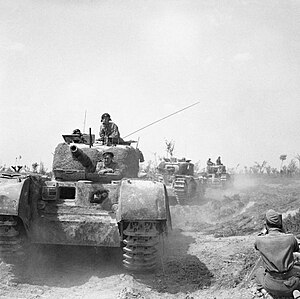Battle of the Argenta Gap
| Battle of the Argenta Gap | |||||||||
|---|---|---|---|---|---|---|---|---|---|
| Part of the Spring 1945 offensive in Italy | |||||||||
 Churchill tanks advance with the British 56th Infantry Division north-east of Argenta. |
|||||||||
|
|||||||||
| Belligerents | |||||||||
|
|
|
||||||||
| Commanders and leaders | |||||||||
|
|
|
||||||||
| Casualties and losses | |||||||||
| ? | Over 3,000 prisoners taken | ||||||||
The Battle of the Argenta Gap was an engagement which formed part of the Allied spring 1945 offensive during the Italian Campaign in the final stages of the Second World War. It took place in northern Italy from 12–19 April 1945 between troops of British V Corps commanded by Lieutenant-General Charles Keightley and German units of LXXVI Panzer Corps commanded by Lieutenant General (General der Panzertruppe) Gerhard von Schwerin.
The Allied invasion of Italy occurred during September 1943, for a number of key reasons not least important of which was that support for the war in Italy had been declining and it was thought that an invasion would hasten the efforts of the new government that had deposed Benito Mussolini, which was seeking peace. Furthermore, the weakening of Axis control of the Mediterranean supply routes eased the pressure on Allied forces operating in the Middle and Far East, as well as on the efforts to supply to Soviet Union.
Operation Husky — the invasion of Sicily in July 1943 — was successful, serving as a springboard for the invasion of the mainland. In September, the first Allied troops to land in Italy were of the British Eighth Army under the then General Bernard Montgomery, in Operation Baytown. Further landings on 9 September 1943 saw the main attack force landing, despite the Italian surrender to the Allied forces on the previous day. After securing the beachheads, the U.S. Fifth Army began its advance northwards.
...
Wikipedia
